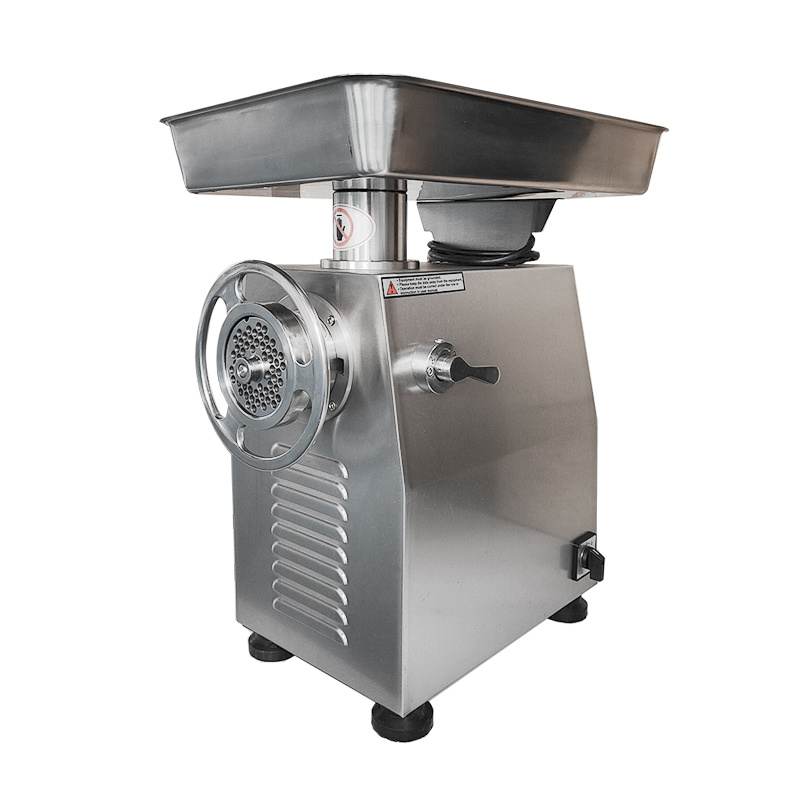Details
I. Core Objectives
1. Improve Efficiency: Automated and continuous production, reducing reliance on manual labor, increasing output and processing speed.
2. Ensure Safety and Hygiene: Comply with food safety regulations such as HACCP and GMP. Equipment is easy to clean and disinfect (CIP/SIP), reducing the risk of cross-contamination.
3. Enhance Product Quality and Consistency: Precise control of processing parameters (temperature, time, cutting size, etc.) ensures stable product quality.
4. Reduce Losses: Fine segmentation and precise processing maximize the use of raw meat and reduce waste.
5. Improve the Working Environment: Reduce labor intensity and the risk of occupational injuries (such as cuts and repetitive strain injuries).
6. Meet Diversified Needs: Adapt to different types of meat (pork, beef, mutton, poultry), different product forms (hot fresh meat, chilled meat, frozen meat, processed products, cooked food, etc.), and different scales (small workshops to large factories) of production requirements.
7. Data and Traceability: Integrate data acquisition and monitoring systems to achieve traceable production processes.
II. Main Application Stages and Solutions
1. Pre-slaughter Processing:
Solution: Animal receiving and resting system, shower cleaning equipment, humane stunning equipment (electrical stunning, CO₂ stunning, etc.), hanging conveyor system.
2. Slaughter and Preliminary Processing:
Solution: Bleeding line, scalding/dehairing equipment (pigs), skinning equipment (cattle, sheep), singeing/polishing equipment, automated evisceration equipment, carcass splitting saw (automatic/semi-automatic), carcass washing machine, pre-cooling/aging room and its conveyor system.
3. Cutting and Deboning:
Solution: This is the core stage with high technical content.
Conveying and Positioning: Hanging conveyor line, workstation conveyor line, precise positioning system (visual guidance).
Primary Cutting: Band saw, circular saw, automatic/semi-automatic carcass cutting machine (such as pig splitting machine, beef quartering machine).
Fine Cutting and Deboning: Handheld pneumatic/electric tools (saws, knives, bone shears), workstations, conveyor belts.
Automation/Robotics: Increasingly popular, used for:
Deboning: Robots use 3D vision and force sensing technology for precise deboning (such as chicken breast, pork ribs, beef hindquarters).
Cutting: Robots cut specific parts of meat (such as steaks, pork chops, meat strips).
Trimming: Robots automatically remove fat, fascia, and bone fragments.
Intelligent Auxiliary System: Automatic sorting, weighing, and labeling system based on weight or part identification.
4. Further Processing:
Solution: Extremely diverse, depending on the final product.
Mincing/Chopping: Mincer, chopper, emulsifier (used for sausages, meat fillings, minced meat products).
Mixing/Tumbling/Marinating: Vacuum/non-vacuum mixer, drum/massage tumbler, injection marinade machine (used to improve tenderness, flavor and water retention).
Forming: Stuffing machine (various calibers), meat patty forming machine, meatball forming machine, meat skewer forming machine, restructured meat forming machine.
Curing/Smoking/Steaming/Baking/Frying: Continuous/batch smoking oven, steamer, baking oven, frying line, pasteurization equipment.
Cooling: Freezer (spiral, fluidized bed), vacuum cooler, cooling tunnel/cooling room.
5. Packaging:
Solution:
Primary Packaging: Tray sealing packaging machine (form-fitting/modified atmosphere), vacuum packaging machine (single chamber/double chamber/continuous), stretch film packaging machine, automatic bagging machine, sausage twisting/clipping/stringing machine.
Secondary Packaging: Automatic cartoning machine, wrapping machine, palletizing robot.
Labeling and Traceability: Automatic labeling machine (including weighing and labeling), inkjet printer, data acquisition and traceability system integration.
6. Auxiliary Systems:
Solution:
Cold Chain: Cold storage, refrigerated truck, temperature monitoring system.
Hygiene Cleaning: CIP cleaning station, high-pressure cleaning equipment, environmental disinfection system.
Material Handling: Lifting platforms, conveyor systems (belt type, slat type, modular plastic chain plate), AGV/RGV vehicles.
By-product Processing: Blood collection and processing equipment, feather/fur processing line, offal processing line, bone-meat separator (for producing meat paste or extracting collagen, etc.).
Wastewater and Waste Gas Treatment: Environmentally compliant treatment facilities.
III. Key Considerations for Selecting Meat Processing Equipment Solutions
1. Product Type and Process: What products are being produced (fresh meat, frozen meat cutting, processed meat, cooked food, sausage, etc.) determines the core type of equipment needed.
2. Capacity Requirements: Hourly output, daily output, and annual output are the basis for selecting equipment specifications and the degree of automation.
3. Raw Material Characteristics: Is it pork, beef, poultry, or seafood? The physical properties of different raw materials (size, hardness, bone-to-meat ratio) have different requirements for the equipment.
4. Degree of Automation: From purely manual, semi-automatic to fully automatic, intelligent robotic production lines, the investment cost and operational efficiency differ greatly.
5. Hygiene Standards and Regulations: Must comply with food safety regulations (such as HACCP) and equipment hygiene design standards (such as EHEDG, 3-A) of the target market (domestic, EU, US, etc.).
6. Space Layout: Available factory space and logistics planning affect equipment selection and layout design.
7. Budget: Initial investment costs and long-term operating costs (energy consumption, maintenance, labor) need to be considered comprehensively.
8. Supplier Capabilities: Technical strength, industry experience, after-sales service (installation, commissioning, training, spare parts supply, maintenance response), and successful cases.
9. Flexibility and Scalability: Can the equipment adapt to future product changes or capacity increases?
10. Data and Intelligence: Does it support data acquisition, process monitoring, quality control, and traceability? Is it easy to integrate into the factory MES/ERP system?
IV. Development Trends
Intelligent and Robotic Automation: The application of 3D vision, AI, and force sensing technology enables robots to perform more complex and precise tasks such as cutting, deboning, and trimming.
Flexible Production: Modular design and quick changeover technology adapt to the market demand for small batches and multiple varieties.
Data-Driven and Interconnected: Industrial Internet of Things and big data analysis are used to optimize production, predict maintenance, improve quality, and ensure traceability.
Ultimate Hygienic Design: No sanitary dead corners, easy to clean, and the application of antibacterial materials.
Energy Saving and Environmental Protection: Low-energy equipment, waste heat recovery, and reduced water and chemical consumption.
Enhance Meat Value: Precise cutting technology maximizes the output of high-value parts; deep processing equipment creates more high-value-added products.
V. How to Obtain Solutions
1. Clarify Needs: Clearly define your core requirements such as products, capacity, budget, site conditions, and target standards.
2. Market Research: Look for professional meat machinery manufacturers and system integrators at home and abroad. Attending industry exhibitions (such as IFFA, China International Meat Industry Exhibition) is a good way.
3. Solution Consultation and Design: Communicate in depth with suppliers to have them provide customized solutions and layout designs based on your needs.
4. Solution Evaluation: Compare different suppliers' solutions (technical advancement, maturity, cost, service, cases) for comprehensive evaluation.
5. Factory Inspection: Visit the supplier's factory and the production lines of successful case customers to understand the equipment operation in person.
6. Business Negotiation and Signing: Determine the final solution, price, delivery time, payment method, and after-sales service terms.
7. Installation, Commissioning, and Training: The supplier is responsible for equipment installation, commissioning, and training of operators and maintenance personnel.
8. Continuous Support: Establish a good cooperative relationship to obtain continuous spare parts supply, technical support, and upgrade services.
key word:

Follow Yuanfang Food Machinery
WhatsApp:+8613790070071
Email:max.huang@fsyuanfang.cn
ADD :No. 4-2, Changjiao Industrial Park 8th Road, Xingtan Town, Shunde District, Foshan City, Guangdong Province

Service hotline: 18923208400
WhatsAPP: 8613790070071
ADD:No.14, Hexi Road, Xingtan Town, Shunde District, Foshan City
Email: 2338821494@qq.com
We will give you feedback in time

 +8618923208400
+8618923208400

